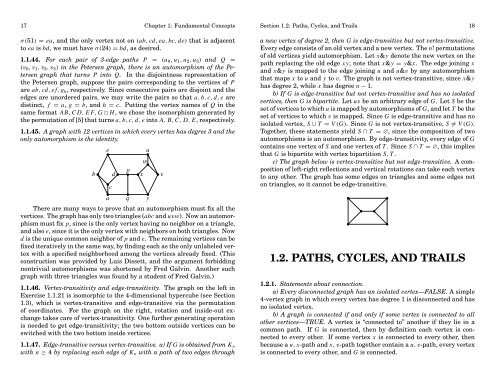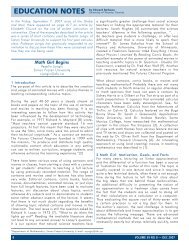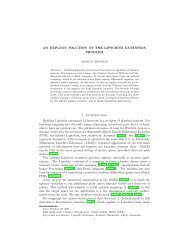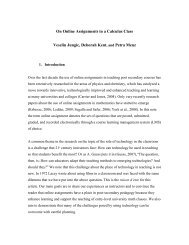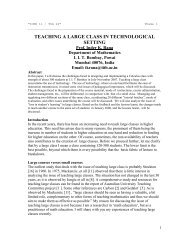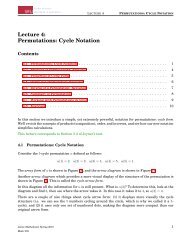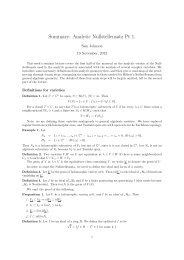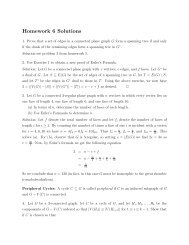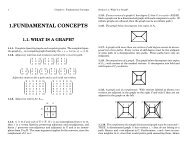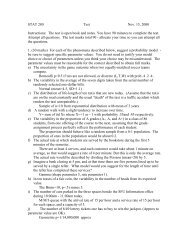1.2. PATHS, CYCLES, AND TRAILS - People.stat.sfu.ca
1.2. PATHS, CYCLES, AND TRAILS - People.stat.sfu.ca
1.2. PATHS, CYCLES, AND TRAILS - People.stat.sfu.ca
You also want an ePaper? Increase the reach of your titles
YUMPU automatically turns print PDFs into web optimized ePapers that Google loves.
17 Chapter 1: Fundamental Concepts Section 1.2: Paths, Cycles, and Trails 18<br />
σ (51) = ea, and the only vertex not on (ab, cd, ea, bc, de) that is adjacent<br />
to ea is bd, we must have σ (24) = bd, as desired.<br />
1.1.44. For each pair of 3-edge paths P = (u0, u1, u2, u3) and Q =<br />
(v0, v1, v2, v3) in the Petersen graph, there is an automorphism of the Petersen<br />
graph that turns P into Q. In the disjointness representation of<br />
the Petersen graph, suppose the pairs corresponding to the vertices of P<br />
are ab, cd, ef, gh, respectively. Since consecutive pairs are disjoint and the<br />
edges are unordered pairs, we may write the pairs so that a, b, c, d, e are<br />
distinct, f = a, g = b, and h = c. Putting the vertex names of Q in the<br />
same format AB, C D, E F, G H, we chose the isomorphism generated by<br />
the permutation of [5] that turns a, b, c, d, e into A, B, C, D, E, respectively.<br />
1.1.45. A graph with 12 vertices in which every vertex has degree 3 and the<br />
only automorphism is the identity.<br />
b •<br />
e<br />
•<br />
•<br />
c<br />
•<br />
a<br />
d •<br />
p<br />
•<br />
•<br />
q<br />
There are many ways to prove that an automorphism must fix all the<br />
vertices. The graph has only two triangles (abc and uvw). Now an automorphism<br />
must fix p, since is the only vertex having no neighbor on a triangle,<br />
and also e, since it is the only vertex with neighbors on both triangles. Now<br />
d is the unique common neighbor of p and e. The remaining vertices <strong>ca</strong>n be<br />
fixed iteratively in the same way, by finding each as the only unlabeled vertex<br />
with a specified neighborhood among the vertices already fixed. (This<br />
construction was provided by Luis Dissett, and the argument forbidding<br />
nontrivial automorphisms was shortened by Fred Galvin. Another such<br />
graph with three triangles was found by a student of Fred Galvin.)<br />
1.1.46. Vertex-transitivity and edge-transitivity. The graph on the left in<br />
Exercise 1.1.21 is isomorphic to the 4-dimensional hypercube (see Section<br />
1.3), which is vertex-transitive and edge-transitive via the permutation<br />
of coordinates. For the graph on the right, rotation and inside-out exchange<br />
takes <strong>ca</strong>re of vertex-transitivity. One further generating operation<br />
is needed to get edge-transitivity; the two bottom outside vertices <strong>ca</strong>n be<br />
switched with the two bottom inside vertices.<br />
1.1.47. Edge-transitive versus vertex-transitive. a) If G is obtained from K n<br />
with n ≥ 4 by replacing each edge of Kn with a path of two edges through<br />
•x<br />
u<br />
•<br />
w<br />
•<br />
•<br />
y<br />
•v<br />
a new vertex of degree 2, then G is edge-transitive but not vertex-transitive.<br />
Every edge consists of an old vertex and a new vertex. The n! permutations<br />
of old vertices yield automorphism. Let x&y denote the new vertex on the<br />
path replacing the old edge xy; note that x&y = y&x. The edge joining x<br />
and x&y is mapped to the edge joining u and u&v by any automorphism<br />
that maps x to u and y to v. The graph is not vertex-transitive, since x&y<br />
has degree 2, while x has degree n − 1.<br />
b) If G is edge-transitive but not vertex-transitive and has no isolated<br />
vertices, then G is bipartite. Let uv be an arbitrary edge of G. Let S be the<br />
set of vertices to which u is mapped by automorphisms of G, and let T be the<br />
set of vertices to which v is mapped. Since G is edge-transitive and has no<br />
isolated vertex, S ∪ T = V (G). Since G is not vertex-transitive, S = V (G).<br />
Together, these <strong>stat</strong>ements yield S ∩ T = ∅, since the composition of two<br />
automorphisms is an automorphism. By edge-transitivity, every edge of G<br />
contains one vertex of S and one vertex of T . Since S ∩ T = ∅, this implies<br />
that G is bipartite with vertex bipartition S, T .<br />
c) The graph below is vertex-transitive but not edge-transitive. A composition<br />
of left-right reflections and verti<strong>ca</strong>l rotations <strong>ca</strong>n take each vertex<br />
to any other. The graph has some edges on triangles and some edges not<br />
on triangles, so it <strong>ca</strong>nnot be edge-transitive.<br />
•<br />
•<br />
•<br />
<strong>1.2.</strong> <strong>PATHS</strong>, <strong>CYCLES</strong>, <strong>AND</strong> <strong>TRAILS</strong><br />
<strong>1.2.</strong>1. Statements about connection.<br />
a) Every disconnected graph has an isolated vertex—FALSE. A simple<br />
4-vertex graph in which every vertex has degree 1 is disconnected and has<br />
no isolated vertex.<br />
b) A graph is connected if and only if some vertex is connected to all<br />
other vertices—TRUE. A vertex is “connected to” another if they lie in a<br />
common path. If G is connected, then by definition each vertex is connected<br />
to every other. If some vertex x is connected to every other, then<br />
be<strong>ca</strong>use a u, x-path and x, v-path together contain a u, v-path, every vertex<br />
is connected to every other, and G is connected.<br />
•<br />
•<br />
•
19 Chapter 1: Fundamental Concepts Section 1.2: Paths, Cycles, and Trails 20<br />
c) The edge set of every closed trail <strong>ca</strong>n be partitioned into edge sets of<br />
cycles—TRUE. The vertices and edges of a closed trail form an even graph,<br />
and Proposition <strong>1.2.</strong>27 applies.<br />
d) If a maximal trail in a graph is not closed, then its endpoints have<br />
odd degree. If an endpoint v is different from the other endpoint, then the<br />
trail uses an odd number of edges incident to v. If v has even degree, then<br />
there remains an incident edge at v on which to extend the trail.<br />
<strong>1.2.</strong>2. Walks in K4.<br />
a) K4 has a walk that is not a trail; repeat an edge.<br />
b) K4 has a trail that is not closed and is not a path; traverse a triangle<br />
and then one additional edge.<br />
c) The closed trails in K4 that are not cycles are single vertices. A closed<br />
trail has even vertex degrees; in K4 this requires degrees 2 or 0, which<br />
forbids connected nontrivial graphs that are not cycles. By convention, a<br />
single vertex forms a closed trail that is not a cycle.<br />
<strong>1.2.</strong>3. The non-coprimality graph with vertex set {1, . . . , 15}. Vertices<br />
1,11,13 are isolated. The remainder induce a single component. It has<br />
a spanning path 7,14,10,5,15,3,9,12,8,6,4,2. Thus there are four components,<br />
and the maximal path length is 11.<br />
<strong>1.2.</strong>4. Effect on the adjacency and incidence matrices of deleting a vertex or<br />
edge. Assume that the graph has no loops.<br />
Consider the vertex ordering v1, . . . , vn. Deleting edge vivj simply<br />
deletes the corresponding column of the incidence matrix; in the adjacency<br />
matrix it reduces positions i, j and j, i by one.<br />
Deleting a vertex vi eliminates the ith row of the incidence matrix,<br />
and it also deletes the column for each edge incident to vi. In the adjacency<br />
matrix, the ith row and ith column vanish, and there is no effect on the<br />
rest of the matrix.<br />
<strong>1.2.</strong>5. If v is a vertex in a connected graph G, then v has a neighbor in every<br />
component of G − v. Since G is connected, the vertices in one component of<br />
G − v must have paths in G to every other component of G − v, and a path<br />
<strong>ca</strong>n only leave a component of G − v via v. Hence v has a neighbor in each<br />
component.<br />
No cut-vertex has degree 1. If G is connected and G − v has k components,<br />
then having a neighbor in each such component yields dG(v) ≥ k. If<br />
v is a cut-vertex, then k ≥ 2, and hence dG(v) ≥ 2.<br />
<strong>1.2.</strong>6. The paw. Maximal paths: acb, abcd, bacd (two are maximum paths).<br />
Maximal cliques: abc, cd (one is a maximum clique). Maximal independent<br />
sets: c, bd, ad (two are maximum independent sets).<br />
b•<br />
a•<br />
c<br />
• •d<br />
<strong>1.2.</strong>7. A bipartite graph has a unique bipartition (except for interchanging<br />
the two partite sets) if and only if it is connected. Let G be a bipartite graph.<br />
If u and v are vertices in distinct components, then there is a bipartition in<br />
which u and v are in the same partite set and another in which they are in<br />
opposite partite sets.<br />
If G is connected, then from a fixed vertex u we <strong>ca</strong>n walk to all other<br />
vertices. A vertex v must be in the same partite set as u if there is a u, vwalk<br />
of even length, and it must be in the opposite set if there is a u, v-walk<br />
of odd length.<br />
<strong>1.2.</strong>8. The biclique Km,n is Eulerian if and only if m and n are both even or<br />
one of them is 0. The graph is connected. It vertices have degrees m and<br />
n (if both are nonzero), which are all even if and only if m and n are both<br />
even. When m or n is 0, the graph has no edges and is Eulerian.<br />
<strong>1.2.</strong>9. The minimum number of trails that decompose the Petersen graph is<br />
5. The Petersen graph has exactly 10 vertices of odd degree, so it needs at<br />
least 5 trails, and Theorem <strong>1.2.</strong>33 implies that five trails suffice.<br />
The Petersen graph does have a decomposition into five paths. Given<br />
the drawing of the Petersen graph consisting of two disjoint 5-cycles and<br />
edges between them, form paths consisting of one edge from each cycle and<br />
one edge joining them.<br />
<strong>1.2.</strong>10. Statements about Eulerian graphs.<br />
a) Every Eulerian bipartite graph has an even number of edges—TRUE.<br />
Proof 1. Every vertex has even degree. We <strong>ca</strong>n count the edges by<br />
summing the degrees of the vertices in one partite set; this counts every<br />
edge exactly once. Since the summands are all even, the total is also even.<br />
Proof 2. Since every walk alternates between the partite sets, following<br />
an Eulerian circuit and ending at the initial vertex requires taking an<br />
even number of steps.<br />
Proof 3. Every Eulerian graph has even vertex degrees and decomposes<br />
into cycles. In a bipartite graph, every cycle has even length. Hence<br />
the number of edges is a sum of even numbers.<br />
b) Every Eulerian simple graph with an even number of vertices has<br />
an even number of edges—FALSE. The union of an even cycle and an odd<br />
cycle that share one vertex is an Eulerian graph with an even number of<br />
vertices and an odd number of edges.
21 Chapter 1: Fundamental Concepts Section 1.2: Paths, Cycles, and Trails 22<br />
<strong>1.2.</strong>11. If G is an Eulerian graph with edges e, f that share a vertex, then<br />
G need not have an Eulerian circuit in which e, f appear consecutively. If<br />
G consists of two edge-disjoint cycles sharing one common vertex v, then<br />
edges incident to v that belong to the same cycle <strong>ca</strong>nnot appear consecutively<br />
on an Eulerian circuit.<br />
<strong>1.2.</strong>12. Algorithm for Eulerian circuit. We convert the proof by extremality<br />
to an iterative algorithm. Assume that G is a connected even graph.<br />
Initialize T to be a closed trail of length 0; a single vertex.<br />
If T is not all of G, we traverse T to reach a vertex v on T that is<br />
incident to an edge e not in T . Beginning from v along e, traversing an<br />
arbitrary trail T ′ not using edges of T ; eventually the trail <strong>ca</strong>nnot be extended.<br />
Since G − E(T ) is an even graph, this <strong>ca</strong>n only happen upon a<br />
return to the original vertex v, completing a closed trail. Splice T ′ into T<br />
by traversing T up to v, then following T ′ , then the rest of T .<br />
If this new trail includes all of E(G), then it is an Eulerian circuit, and<br />
we stop. Otherwise, let this new trail be T and repeat the iterative step.<br />
Since each successive trail is longer and G has finitely many edges, the<br />
procedure must terminate. It <strong>ca</strong>n only terminate when an Eulerian circuit<br />
has been found.<br />
<strong>1.2.</strong>13. Each u, v-walk contains a u, v-path.<br />
a) (induction). We use ordinary induction on the length l of the walk,<br />
proving the <strong>stat</strong>ement for all pairs of vertices. A u, v-walk of length 1 is<br />
a u, v-path of length 1; this provides the basis. For the induction step,<br />
suppose l > 1, and let W be a u, v-walk of length l; the induction hypothesis<br />
is that walks of length less than l contain paths linking their endpoints. If<br />
u = v, the desired path has length 0. If u = v, let wv be the last edge of W ,<br />
and let W ′ be the u, w-walk obtained by deleting wv from W . Since W ′ has<br />
length l − 1, the induction hypothesis guarantees a u, w-path P in W ′ . If<br />
w = v, then P is the desired u, v-path. If w = v and v is not on P, then we<br />
extend P by the edge wv to obtain a u, v-path. If w = v and v is on P, then<br />
P contains a u, v-path. In each <strong>ca</strong>se, the edges of the u, v-path we construct<br />
all belong to W .<br />
u•<br />
w•<br />
•v<br />
b) (extremality) Given a u, v-walk W , consider a shortest u, v-walk W ′<br />
contained in W . If this is not a path, then it has a repeated vertex, and<br />
the portion between the instances of one vertex <strong>ca</strong>n be removed to obtain a<br />
shorter u, v-walk in W than W ′ .<br />
<strong>1.2.</strong>14. The union of the edge sets of distinct u, v-paths contains a cycle.<br />
Proof 1 (extremality). Let P and Q be distinct u, v-paths. Since a<br />
path in a simple graph is determined by its set of edges, we may assume<br />
(by symmetry) that P has an edge e not belonging to Q. Within the portion<br />
of P before P traverses e, let y be the last vertex that belongs to Q. Within<br />
the portion of P after P traverses e, let z be the first vertex that belongs<br />
to Q. The vertices y, z exist, be<strong>ca</strong>use u, v ∈ V (Q). The y, z-subpath of<br />
P combines with the y, z- or z, y-subpath of Q to form a cycle, since this<br />
subpath of Q contains no vertex of P between y and z.<br />
Proof 2 (induction). We use induction on the sum l of the lengths of<br />
the two paths, for all vertex pairs simultaneously. If P and Q are u, vpaths,<br />
then l ≥ 2. If l = 2, then we have distinct edges consisting of u and<br />
v, and together they form a cycle of length 2. For the induction step, suppose<br />
l > 2. If P and Q have no common internal vertices, then their union<br />
is a cycle. If P and Q have a common internal vertex w, then let P ′ , P ′′ be<br />
the u, w-subpath of P and the w, v-subpath of P. Similarly define Q ′ , Q ′′ .<br />
Then P ′ , Q ′ are u, w-paths with total length less than l. Similarly, P ′′ , Q ′′<br />
are w, v-paths with total length less than l. Since P, Q are distinct, we<br />
must have P ′ , Q ′ distinct or P ′′ , Q ′′ distinct. We <strong>ca</strong>n apply the induction<br />
hypothesis to the pair that is a pair of distinct paths joining the same endpoints.<br />
This pair contains the edges of a cycle, by the induction hypothesis,<br />
which in turn is contained in the union of P and Q.<br />
The union of distinct u, v-walks need not contain a cycle. Let G =<br />
P3, with vertices u, x, v in order. The distinct u, v-walks with vertex lists<br />
u, x, u, x, v and u, x, v, x, v do not contain a cycle in their union.<br />
<strong>1.2.</strong>15. If W is a nontrivial closed walk that does not contain a cycle, then<br />
some edge of W occurs twice in succession (once in each direction).<br />
Proof 1 (induction on the length l of W ). We are given l ≥ 1. A closed<br />
walk of length 1 is a loop, which is a cycle. Thus we may assume l ≥ 2.<br />
Basis step: l = 2. Since it contains no cycle, the walk must take a step<br />
and return immediately on the same edge.<br />
Induction step: l > 2. If there is no vertex repetition other than first<br />
vertex = last vertex, then W traverses a cycle, which is forbidden. Hence<br />
there is some other vertex repetition. Let W ′ be the portion of W between<br />
the instances of such a repetition. The walk W ′ is a shorter closed walk<br />
than W and contains no cycle, since W has none. By the induction hypothesis,<br />
W ′ has an edge repeating twice in succession, and this repetition also<br />
appears in W .<br />
Proof 2. Let w be the first repetition of a vertex along W , arriving<br />
from v on edge e. From the first occurrence of w to the visit to v is a w, vwalk,<br />
which is a cycle if v = w or contains a nontrivial w, v-path P. This
23 Chapter 1: Fundamental Concepts Section 1.2: Paths, Cycles, and Trails 24<br />
completes a cycle with e unless in fact P is the path of length 1 with edge<br />
e, in which <strong>ca</strong>se e repeats immediately in opposite directions.<br />
<strong>1.2.</strong>16. If edge e appears an odd number of times in a closed walk W , then<br />
W contains the edges of a cycle through e.<br />
Proof 1 (induction on the length of W , as in Lemma <strong>1.2.</strong>7). The shortest<br />
closed walk has length 1. Basis step (l = 1): The edge e in a closed walk<br />
of length 1 is a loop and thus a cycle. Induction step (l > 1): If there is no<br />
vertex repetition, then W is a cycle. If there is a vertex repetition, choose<br />
two appearances of some vertex (other than the beginning and end of the<br />
walk). This splits the walk into two closed walks shorter than W . Since<br />
each step is in exactly one of these subwalks, one of them uses e an odd<br />
number of times. By the induction hypothesis, that subwalk contains the<br />
edges of a cycle through e, and this is contained in W .<br />
Proof 2 (parity first, plus Lemma <strong>1.2.</strong>6). Let x and y be the endpoints<br />
of e. As we traverse the walk, every trip through e is x, e, y or y, e, x. Since<br />
the number of trips is odd, the two types <strong>ca</strong>nnot alternate. Hence some two<br />
successive trips through e have the same direction. By symmetry, we may<br />
assume that this is x, e, y, . . . , x, e, y.<br />
The portion of the walk between these two trips through e is a y, xwalk<br />
that does not contain e. By Lemma <strong>1.2.</strong>6, it contains a y, x-path (that<br />
does not contain e. Adding e to this path completes a cycle with e consisting<br />
of edges in W .<br />
Proof 3 (contrapositive). If edge e in walk W does not lie on a cycle<br />
consisting of edges in W , then by our characterization of cut-edges, e is a<br />
cut-edge of the subgraph H consisting of the vertices and edges in W . This<br />
means that the walk <strong>ca</strong>n only return to e at the endpoint from which it most<br />
recently left e. This requires the traversals of e to alternate directions along<br />
e. Since a closed walk ends where it starts (that is, in the same component<br />
of H − e), the number of traversals of e by W must be even.<br />
<strong>1.2.</strong>17. The “adjacent-transposition graph” Gn on permutations of [n] is<br />
connected. Note that since every permutation of [n] has n − 1 adjacent<br />
pairs that <strong>ca</strong>n be transposed, Gn is (n −1)-regular. Therefore, showing that<br />
Gn is connected shows that it is Eulerian if and only if n is odd.<br />
Proof 1 (path to fixed vertex). We show that every permutation has<br />
a path to the identity permutation I = 1, . . . , n. By the transitivity of the<br />
connection relation, this yields for all u, v ∈ V (G) a u, v-path in G. To<br />
create a v, I -path, move element 1 to the front by adjacent interchanges,<br />
then move 2 forward to position 2, and so on. This builds a walk to I , which<br />
contains a path to I . (Actually, this builds a path.)<br />
Proof 2 (direct u, v-path). Each vertex is a permutation of [n]. Let<br />
u = a1, . . . , an and v = b1, . . . , bn; we construct at u, v-path. The element<br />
b1 appears in u as some ai; move it to the front by adjacent transpositions,<br />
beginning a walk from u. Next find b2 among a2, . . . , an and move it to<br />
position 2. Iterating this procedure brings the elements of v toward the<br />
front, in order, while following a walk. It reaches v when all positions have<br />
been “corrected”. (Actually, the walk is a u, v-path.) Note that since we<br />
always bring the desired element forward, we never disturb the position of<br />
the elements that were already moved to their desired positions.<br />
Proof 3 (induction on n). If n = 1, then Gn ∼ = K1 and G is connected<br />
(we <strong>ca</strong>n also start with n = 2). For n > 1, assume that Gn−1 is connected.<br />
In Gn, the subgraph H induced by the vertices having n at the end is isomorphic<br />
to Gn−1. Every vertex of G is connected to a vertex of H by a path<br />
formed by moving element n to the end, one step at a time. For u, v ∈ V (G),<br />
we thus have a path from u to a vertex u ′ ∈ V (H), a path from v to a vertex<br />
v ′ ∈ V (H), and a u ′ , v ′ -path in H that exists by the induction hypothesis.<br />
By the transitivity of the connection relation, there is a u, v-path in G.<br />
This completes the proof of the induction step. (The part of G 4 used in the<br />
induction step appears below.)<br />
4132 •<br />
1432 •<br />
1342 •<br />
1324 •<br />
3142<br />
4312 • • • • 3124<br />
3412<br />
3214 •<br />
3241 •<br />
3421 •<br />
4321 •<br />
• 4123<br />
• 1423<br />
• 1243<br />
• 1234<br />
2413<br />
2134 • • • • 4213<br />
2143<br />
• 2314<br />
• 2341<br />
• 2431<br />
• 4231<br />
Proof 4 (induction on n). The basis is as in Proof 3. For n > 1, note<br />
that for each i ∈ [n], the vertices with i at the end induce a copy Hi of<br />
Gn−1. By the induction hypothesis, each such subgraph is connected. Also,<br />
Hn has vertices with i in position n − 1 whenever 1 ≤ i ≤ n − 1. We <strong>ca</strong>n<br />
interchange the last two positions to obtain a neighbor in Hi. Hence there<br />
is an edge from each Hi to Hn, and transitivity of the connection relation<br />
again completes the proof.<br />
<strong>1.2.</strong>18. For k ≥ 1, there are two components in the graph G k whose vertex<br />
set is the set of binary k-tuples and whose edge set consists of the pairs that<br />
differ in exactly two places. Changing two coordinates changes the number<br />
of 1s in the name of the vertex by zero or by ±2. Thus the parity of the
25 Chapter 1: Fundamental Concepts Section 1.2: Paths, Cycles, and Trails 26<br />
number of 1s remains the same along every edge. This implies that G k has<br />
at least two components, be<strong>ca</strong>use there is no edge from an k-tuple with an<br />
even number of 1s to an k-tuple with an odd number of 1s.<br />
To show that Gk has at most two components, there are several approaches.<br />
In each, we prove that any two vertices with the same parity lie<br />
on a path, where “parity” means parity of the number of 1s.<br />
Proof 1. If u and v are vertices with the same parity, then they differ<br />
in an even number of places. This is true be<strong>ca</strong>use each change of a bit in<br />
obtaining one label from the other switches the parity. Since they differ<br />
in an even number of places, we <strong>ca</strong>n change two places at a time to travel<br />
from u to v along a path in Gk.<br />
Proof 2. We use induction on k. Basis step (k = 1): G1 has two<br />
components, each an isolated vertex. Induction step (k > 1): when k > 1,<br />
Gk consists of two copies of Gk−1 plus additional edges. The two copies are<br />
obtained by appending 0 to all the vertex names in G k−1 or appending 1<br />
to them all. Within a copy, the edges don’t change, since these vertices<br />
all agree in the new place. By the induction hypothesis, each subgraph<br />
has two components. The even piece in the 0-copy has 0 · · · 000, which is<br />
adjacent to 0 · · · 011 in the odd piece of the 1-copy. The odd piece in the<br />
0-copy has 0 · · · 010, which is adjacent to 0 · · · 001 in the even piece of the<br />
1-copy. Thus the four pieces reduce to (at most) two components in G k.<br />
<strong>1.2.</strong>19. For n, r, s ∈ N, the simple graph G with vertex set Zn and edge set<br />
{i j: | j − i| ∈ {r, s}} has gcd(n, r, s) components. Note: The text gives the<br />
vertex set incorrectly. When r = s = 2 and n is odd, it is necessary to go up<br />
to n ≡ 0 to switch from odd to even.<br />
Let k = gcd(n, r, s). Since k divides n, the congruence classes modulo n<br />
fall into congruence classes modulo k in a well-defined way. All neighbors of<br />
vertex i differ from i by a multiple of k. Thus all vertices in a component lie<br />
in the same congruence class modulo k, which makes at least k components.<br />
To show that there are only k components, we show that all vertices<br />
with indices congruent to i (mod k) lie in one component (for each i). It<br />
suffices to build a path from i to i + k. Let l = gcd(r, s), and let a = r/l and<br />
b = s/l. Since there are integers (one positive and one negative) such that<br />
pa +qb = 1, moving p edges with difference +r and q edges with difference<br />
+s achieves a change of +l.<br />
We thus have a path from i to i + l, for each i. Now, k = gcd(l, n). As<br />
above, there exist integers p ′ , q ′ such that p ′ (l/k) + q ′ (n/k) = 1. Rewriting<br />
this as p ′ l = k − q ′ n means that if we use p ′ of the paths that add l, then<br />
we will have moved from i to i + k (mod n).<br />
<strong>1.2.</strong>20. If v is a cut-vertex of a simple graph G, then v is not a cut-vertex<br />
of G. Let V1, . . . , Vk be the vertex sets of the components of G − v; note<br />
that k ≥ 2. Then G contains the complete multipartite graph with partite<br />
sets V1, . . . , Vk. Since this includes all vertices of G − v, the graph G − v is<br />
connected. Hence v is not a cut-vertex of G.<br />
<strong>1.2.</strong>21. A self-complementary graph has a cut-vertex if and only if it has a<br />
vertex of degree 1. If there is a vertex of degree 1, then its neighbor is a<br />
cut-vertex (K2 is not self-complementary).<br />
For the converse, let v be a cut-vertex in a self-complementary graph<br />
G. The graph G − v has a spanning biclique, meaning a complete bipartite<br />
subgraph that contains all its vertices. Since G is self-complementary, also<br />
G must have a vertex u such that G − u has a spanning biclique.<br />
Since each vertex of G − v is nonadjacent to all vertices in the other<br />
components of G − v, a vertex other than u must be in the same partite set<br />
of the spanning biclique of G − u as the vertices not in the same component<br />
as u in G − v. Hence only v <strong>ca</strong>n be in the other partite set, and v has degree<br />
at least n − 2. We conclude that v has degree at most 1 in G, so G has a<br />
vertex of degree at most 1. Since a graph and its complement <strong>ca</strong>nnot both<br />
be disconnected, G has a vertex of degree 1.<br />
<strong>1.2.</strong>22. A graph is connected if and only if for every partition of its vertices<br />
into two nonempty sets, there is an edge with endpoints in both sets.<br />
Necessity. Let G be a connected graph. Given a partition of V (G) into<br />
nonempty sets S, T , choose u ∈ S and v ∈ T . Since G is connected, G has a<br />
u, v-path P. After its last vertex in S, P has an edge from S to T .<br />
Sufficiency.<br />
Proof 1 (contrapositive). We show that if G is not connected, then for<br />
some partition there is no edge across. In particular, if G is disconnected,<br />
then let H be a component of G. Since H is a maximal connected subgraph<br />
of G and the connection relation is transitive, there <strong>ca</strong>nnot be an<br />
edges with one endpoint in V (H) and the other endpoint outside. Thus for<br />
the partition of V (G) into V (H) and V (G) − V (H) there is no edge with<br />
endpoints in both sets.<br />
Proof 2 (algorithmic approach). We grow a set of vertices that lie in<br />
the same equivalence class of the connection relation, eventually accumulating<br />
all vertices. Start with one vertex in S. While S does not include all<br />
vertices, there is an edge with endpoints x ∈ S and y /∈ S. Adding y to S<br />
produces a larger set within the same equivalence class, using the transitivity<br />
of the connection relation. This procedure ends only when there are<br />
no more vertices outside S, in which <strong>ca</strong>se all of G is in the same equivalence<br />
class, so G has only one component.<br />
Proof 3 (extremality). Given a vertex x ∈ V (G), let S be the set of all<br />
vertices that <strong>ca</strong>n be reached from x via paths. If S = V (G), consider the<br />
partition into S and V (G)− S. By hypothesis, G has an edge with endpoints
27 Chapter 1: Fundamental Concepts Section 1.2: Paths, Cycles, and Trails 28<br />
u ∈ S and v /∈ S. Now there is an x, v-path formed by extending an x, upath<br />
along the edge uv. This contradicts the choice of S, so in fact S is all<br />
of V (G). Since there are paths from x to all other vertices, the transitivity<br />
of the connection relation implies that G is connected.<br />
<strong>1.2.</strong>23. a) If a connected simple graph G is not a complete graph, then every<br />
vertex of G belongs to some induced subgraph isomorphic to P3. Let v be a<br />
vertex of G. If the neighborhood of v is not a clique, then v has a pair x, y<br />
of nonadjacent neighbors; {x, v, y} induces P3. If the neighborhood of v is a<br />
clique, then since G is not complete there is some vertex y outside the set S<br />
consisting of v and its neighbors. Since G is connected, there is some edge<br />
between a neighbor w of v and a vertex x that is not a neighbor of v. Now<br />
the set {v, w, x} induces P3, since x is not a neighbor of v.<br />
One <strong>ca</strong>n also use <strong>ca</strong>ses according to whether v is adjacent to all other<br />
vertices or not. The two <strong>ca</strong>ses are similar to those above.<br />
b) When a connected simple graph G is not a complete graph, G may<br />
have edges that belong to no induced subgraph isomorphic to P3. In the<br />
graph below, e lies in no such subgraph.<br />
•<br />
e<br />
•<br />
• •<br />
<strong>1.2.</strong>24. If a simple graph with no isolated vertices has no induced subgraph<br />
with exactly two edges, then it is a complete graph. Let G be such a graph.<br />
If G is disconnected, then edges from two components yield four vertices<br />
that induce a subgraph with two edges. If G is connected and not complete,<br />
then G has nonadjacent vertices x and y. Let Q be a shortest x, y-path; it<br />
has length at least 2. Any three successive vertices on Q induce P3, with<br />
two edges.<br />
Alternatively, one <strong>ca</strong>n use proof by contradiction. If G is not complete,<br />
then G has two nonadjacent vertices. Considering several <strong>ca</strong>ses (common<br />
neighbor or not, etc.) always yields an induced subgraph with two edges.<br />
<strong>1.2.</strong>25. Inductive proof that every graph G with no odd cycles is bipartite.<br />
Proof 1 (induction on e(G)). Basis step (e(G) = 0): Every graph with<br />
no edges is bipartite, using any two sets covering V (G).<br />
Induction step (e(G) > 0): Dis<strong>ca</strong>rding an edge e introduces no odd<br />
cycles. Thus the induction hypothesis implies that G − e is bipartite.<br />
If e is a cut-edge, then combining bipartitions of the components of<br />
G − e so that the endpoints of e are in opposite sets produces a bipartition<br />
of G. If e is not a cut-edge of G, then let u and v be its endpoints, and let<br />
X, Y be a bipartition of G − e. Adding e completes a cycle with a u, v-path<br />
in G − e; by hypothesis, this cycle has even length. This forces u and v to be<br />
in opposite sets in the bipartition X, Y . Hence the bipartition X, Y of G − e<br />
is also a bipartition of G.<br />
Proof 2 (induction on n(G)). Basis step (n(G) = 1): A graph with one<br />
vertex and no odd cycles has no loop and hence no edge and is bipartite.<br />
Induction step (n(G) > 1): When we dis<strong>ca</strong>rd a vertex v, we introduce<br />
no odd cycles. Thus the induction hypothesis implies that G −v is bipartite.<br />
Let G1, . . . , Gk be the components of G − v; each has a bipartition. If v has<br />
neighbors u, w in both parts of the bipartition of Gi, then the edges uv and<br />
vw and a shortest u, w-path in Gi form a cycle of odd length. Hence we <strong>ca</strong>n<br />
specify the bipartition Xi, Yi of Gi so that Xi contains all neighbors of v in<br />
Gi. We now have a bipartition of G by letting X = Xi and Y = {v}∪( Yi).<br />
<strong>1.2.</strong>26. A graph G is bipartite if and only if for every subgraph H of G,<br />
there is an independent set containing at least half of the vertices of H.<br />
Every bipartite graph has a vertex partition into two independent sets, one<br />
of which must contain at least half the vertices (though it need not be a<br />
maximum independent set). Since every subgraph of a bipartite graph is<br />
bipartite, the argument applies to all subgraphs of a bipartite graph, and<br />
the condition is necessary.<br />
For the converse, suppose that G is not bipartite. By the characterization<br />
of bipartite graphs, G contains an odd cycle H. This subgraph H<br />
has no independent set containing at least half its vertices, be<strong>ca</strong>use every<br />
set consisting of at least half the vertices in an odd cycle must have two<br />
consecutive vertices on the cycle.<br />
<strong>1.2.</strong>27. The “transposition graph” on permutations of [n] is bipartite. The<br />
partite sets are determined by the parity of the number of pairs i, j such<br />
that i < j and ai > aj (these are <strong>ca</strong>lled inversions). We claim that each<br />
transposition changes the parity of the number of inversions, and therefore<br />
each edge in the graph joins vertices with opposite parity. Thus the<br />
permutations with an even number of inversions form an independent set,<br />
as do those with an odd number of inversions. This is a bipartition, and<br />
thus the graph is bipartite.<br />
Consider the transposition that interchanges the elements in position<br />
r and position s, with r < s. No pairs involving elements that are before r<br />
or after s have their order changed. If r < k < s, then interchanging ar and<br />
as changes the order of ar and ak, and also it changes the order of ak and as.<br />
Thus for each such k the number of inversions changes twice and retains<br />
the same parity. This describes all changes in order except for the switch<br />
of ar and as itself. Thus the total number of changes is odd, and the parity<br />
of the number of inversions changes.
29 Chapter 1: Fundamental Concepts Section 1.2: Paths, Cycles, and Trails 30<br />
<strong>1.2.</strong>28. a) The graph below has a unique largest bipartite subgraph, obtained<br />
by deleting the central edge. Deleting the central edge leaves a<br />
bipartite subgraph, since the indi<strong>ca</strong>ted sets A and B are independent in<br />
that subgraph. If deleting one edge makes a graph bipartite, then that<br />
edge must belong to all odd cycles in the graph, since a bipartite subgraph<br />
has no odd cycles. The two odd cycles in bold have only the central edge in<br />
common, so no other edge belongs to all odd cycles.<br />
B A<br />
B • • • • • • B<br />
A B<br />
•<br />
A<br />
b) In the graph below, the largest bipartite subgraph has 10 edges, and<br />
it is not unique. Deleting edges bh and ag yields an X, Y -bigraph with X =<br />
{b, c, e, h} and Y = {a, d, f, g}. Another bipartite subgraph with 10 edges is<br />
obtained by deleting edges de and cf ; the bipartition is X = {b, c, f, g} and<br />
Y = {a, d, e, h}. (Although these two subgraphs are isomorphic, they are<br />
two subgraphs, just as the Petersen graph has ten claws, not one.)<br />
It remains to show that we must delete at least two edges to obtain a<br />
bipartite subgraph. By the characterization of bipartite graphs, we must<br />
delete enough edges to break all odd cycles. We <strong>ca</strong>n do this with (at most)<br />
one edge if and only if all the odd cycles have a common edge. The 5-cycles<br />
(b, a, c, f, h) and (b, d, e, g, h) have only the edge bh in common. Therefore,<br />
if there is a single edge lying in all odd cycles, it must be bh. However,<br />
(a, c, f, h, g) is another 5-cycle that does not contain this. Therefore no<br />
edge lies in all odd cycles, and at least two edges must be deleted.<br />
b d<br />
• •<br />
•<br />
a<br />
A<br />
•<br />
• •<br />
c e<br />
f h<br />
• •<br />
<strong>1.2.</strong>29. A connected simple graph not having P4 or C3 as an induced subgraph<br />
is a biclique. Choose a vertex x. Since G has no C3, N(x) is independent.<br />
Let S = V (G) − N(X) − {x}. Every v ∈ S has a neighbor in N(x);<br />
otherwise, a shortest v, x-path contains an induced P4. If v ∈ S is adjacent<br />
to w but not z in N(x), then v, w, x, z is an induced P4. Hence all of S is adjacent<br />
to all of N(x). Now S ∪ {x} is an independent set, since G has no C3.<br />
We have proved that G is a biclique with bipartition N(x), S ∪ {x}.<br />
•<br />
g<br />
<strong>1.2.</strong>30. Powers of the adjacency matrix.<br />
a) In a simple graph G, the (i, j)th entry in the kth power of the adjacency<br />
matrix A is the number of (vi, vj)-walks of length k in G. We use<br />
induction on k. When k = 1, ai, j counts the edges (walks of length 1) from<br />
i to j. When k > 1, every (vi, vj)-walk of length k has a unique vertex<br />
vr reached one step before the end at vj. By the induction hypothesis, the<br />
number of (vi, vr)-walks of length k −1 is entry (i, r) in Ak−1 , which we write<br />
as a (k−1)<br />
i,r . The number of (vi, vj)-paths of length k that arrive via vr on the<br />
last step is a (k−1)<br />
i,r<br />
ar, j, since ar, j is the number of edges from vr to vj that <strong>ca</strong>n<br />
complete the walk. Counting the (vi, vj)-walks of length k by which vertex<br />
appears one step before vj yields n ar, j. By the definition of ma-<br />
r=1 a(k−1)<br />
i,r<br />
trix multipli<strong>ca</strong>tion, this is the (i, j)th entry in Ak . (The proof allows loops<br />
and multiple edges and applies without change for digraphs. When loops<br />
are present, note that there is no choice of “direction” on a loop; a walk is<br />
a list of edge traversals).<br />
b) A simple graph G with adjacency matrix A is bipartite if and only<br />
if, for each odd integer r, the diagonal entries of the matrix Ar are all 0. By<br />
part (a), Ar i,i counts the closed walks of length r beginning at vi. If this is<br />
always 0, then G has no closed walks of odd length through any vertex; in<br />
particular, G has no odd cycle and is bipartite. Conversely, if G is bipartite,<br />
then G has no odd cycle and hence no closed odd walk, since every closed<br />
odd walk contains an odd cycle.<br />
<strong>1.2.</strong>31. Kn is the union of k bipartite graphs if and only if n ≤ 2 k (without<br />
using induction).<br />
a) Construction when n ≤ 2 k . Given n ≤ 2 k , encode the vertices of<br />
Kn as distinct binary k-tuples. Let Gi be the complete bipartite subgraph<br />
with bipartition Xi, Yi, where Xi is the set of vertices whose codes have 0<br />
in position i, and Yi is the set of vertices whose codes have 1 in position i.<br />
Since every two vertex codes differ in some position, G 1 ∪ · · · ∪ Gk = Kn.<br />
b) Upper bound. Given that Kn is a union of bipartite graphs<br />
G1, . . . , Gk, we define a code for each vertex. For 1 ≤ i ≤ k, let X i, Yi<br />
be a bipartition of Gi. Assign vertex v the code (a1, . . . , ak), where ai = 0 if<br />
v ∈ Xi, and ai = 1 if v ∈ Yi or v /∈ Xi ∪ Yi. Since every two vertices are adjacent<br />
and the edge joining them must be covered in the union, they lie in<br />
opposite partite sets in some Gi. Therefore the codes assigned to the vertices<br />
are distinct. Since the codes are binary k-tuples, there are at most 2 k<br />
of them, so n ≤ 2 k .<br />
<strong>1.2.</strong>32. “Every maximal trail in an even graph is an Eulerian circuit”—<br />
FALSE. When an even graph has more than one component, each component<br />
has a maximal trail, and it will not be an Eulerian circuit unless the
31 Chapter 1: Fundamental Concepts Section 1.2: Paths, Cycles, and Trails 32<br />
other components have no edges. The added hypothesis needed is that the<br />
graph is connected.<br />
The proof of the corrected <strong>stat</strong>ement is essentially that of Theorem<br />
<strong>1.2.</strong>32. If a maximal trail T is not an Eulerian circuit, then it is incident<br />
to a missing edge e, and a maximal trail in the even graph G − E(T ) that<br />
starts at e <strong>ca</strong>n be inserted to enlarge T , which contradicts the hypothesis<br />
that T is a maximal trail.<br />
<strong>1.2.</strong>33. The edges of a connected graph with 2k odd vertices <strong>ca</strong>n be partitioned<br />
into k trails if k > 0. The assumption of connectedness is necessary,<br />
be<strong>ca</strong>use the conclusion is not true for G = H1 + H2 when H1 has some odd<br />
vertices and H2 is Eulerian.<br />
Proof 1 (induction on k). When k = 1, we add an edge between the<br />
two odd vertices, obtain an Eulerian circuit, and delete the added edge.<br />
When k > 1, let P be a path connecting two odd vertices. The graph G ′ =<br />
G − E(P) has 2k −2 odd vertices, since deleting E(P) changes degree parity<br />
only at the ends of P. The induction hypothesis applies to each component<br />
of G ′ that has odd vertices. Any component not having odd vertices has<br />
an Eulerian circuit that contains a vertex of P; we splice it into P to avoid<br />
having an additional trail. In total, we have used the desired number of<br />
trails to partition E(G).<br />
Proof 2 (induction on e(G)). If e(G) = 1, then G = K2, and we have<br />
one trail. If G has an even vertex x adjacent to an odd vertex y, then G ′ =<br />
G − xy has the same number of odd vertices as G. The trail decomposition<br />
of G ′ guaranteed by the induction hypothesis has one trail ending at x and<br />
no trail ending at y. Add xy to the trail ending at x to obtain the desired<br />
decomposition of G. If G has no even vertex adjacent to an odd vertex, then<br />
G is Eulerian or every vertex of G is odd. In this <strong>ca</strong>se, deleting an edge xy<br />
reduces k, and we <strong>ca</strong>n add xy as a trail of length one to the decomposition<br />
of G − xy guaranteed by the induction hypothesis.<br />
<strong>1.2.</strong>34. The graph below has 6 equivalence classes of Eulerian circuits. If<br />
two Eulerian circuits follow the same circular arrangement of edges, differing<br />
only in the starting edges or the direction, then we consider them<br />
equivalent. An equivalence class of circuits is characterized by the pairing<br />
of edges at each vertex corresponding to visits through that vertex.<br />
A 2-valent vertex has exactly one such pairing; a 4-valent vertex has<br />
three possible pairings. The only restriction is that the pairings must yield<br />
a single closed trail. Given a pairing at one 4-valent vertex below, there is a<br />
forbidden pairing at the other, be<strong>ca</strong>use it would produce two edge-disjoint<br />
4-cycles instead of a single trail. The other two choices are okay. Thus the<br />
answer is 3 · 2 = 6.<br />
•<br />
y<br />
a• b• •c •d<br />
x<br />
•<br />
Alternatively, think of making choices while following a circuit. Be<strong>ca</strong>use<br />
each circuit uses each edge, and be<strong>ca</strong>use the reversal of a circuit C<br />
is in the same class as C, we may follow a <strong>ca</strong>noni<strong>ca</strong>l representative of the<br />
class from a along ax. We now count the choices made to determine the circuit.<br />
After x we <strong>ca</strong>n follow one of 3 choices. This leads us through another<br />
neighbor of x to y. Now we <strong>ca</strong>nnot use the edge ya or the edge just used,<br />
so two choices remain. This determines the rest of the circuit. For each of<br />
the three ways to make the initial choice, there was a choice of two later,<br />
so there are 3 · 2 = 6 ways to specify distinct classes of circuits. (Distinct<br />
ways of making the choices yields a distinct pairing at some vertex.)<br />
<strong>1.2.</strong>35. Algorithm for Eulerian circuits. Let G be a connected even graph.<br />
At each vertex partition the incident edges into pairs (each edge appears in<br />
a pair at each endpoint). Start along some edge. At each arrival at a vertex,<br />
there is an edge paired with the entering edge; use it to exit. This <strong>ca</strong>n end<br />
only by arriving at the initial vertex along the edge paired with the initial<br />
edge, and it must end since the graph is finite. At the point where the first<br />
edge would be repeated, stop; this completes a closed trail. Furthermore,<br />
there is no choice in assembling this trail, so every edge appears in exactly<br />
one such trail. Therefore, the pairing decomposes G into closed trails.<br />
If there is more than one trail in the decomposition, then there are<br />
two trails with a common vertex, since G is connected. (A shortest path<br />
connecting vertices in two of the trails first leaves the first trail at some<br />
vertex v, and at v we have edges from two different trails.) Given edges<br />
from trails A and B at v, change the pairing by taking a pair in A and a<br />
pair in B and switching them to make two pairs that pair an edge of A with<br />
an edge of B. Now when A is followed from v, the return to A does not end<br />
the trail, but rather the trail continues and follows B before returning to<br />
the original edge. Thus changing the pairing at v combines these two trails<br />
into one trail and leaves the other trails unchanged.<br />
We have shown that if the number of trails in the decomposition exceeds<br />
one, then we <strong>ca</strong>n obtain a decomposition with fewer trails be changing<br />
the pairing. Repeating the argument produces a decomposition using one<br />
closed trail. This trail is an Eulerian circuit.
33 Chapter 1: Fundamental Concepts Section 1.2: Paths, Cycles, and Trails 34<br />
<strong>1.2.</strong>36. Alternative characterization of Eulerian graphs.<br />
a) If G is loopless and Eulerian and G ′ = G − uv, then G ′ has an odd<br />
number of u, v-trails that visit v only at the end.<br />
Proof 1 (exhaustive counting and parity). Every extension of every<br />
trail from u in G ′ eventually reaches v, be<strong>ca</strong>use a maximal trail ends only<br />
at a vertex of odd degree. We maintain a list of trails from u. The number<br />
of choices for the first edge is odd. For a trail T that has not yet reached v,<br />
there are an odd number of ways to extend T by one edge. We replace T in<br />
the list by these extensions. This changes the number of trails in the list<br />
by an even number. The process ends when all trails in the list end at v.<br />
Since the list always has odd size, the total number of these trails is odd.<br />
Proof 2 (induction and stronger result). We prove that the same conclusion<br />
holds whenever u and v are the only vertices of odd degree in a<br />
graph H, regardless of whether they are adjacent. This is immediate if H<br />
has only the edge uv. For larger graphs, we show that there are an odd<br />
number of such trails starting with each edge e incident to u, so the sum is<br />
odd. If e = uv, then there is one such trail. Otherwise, when e = uw with<br />
w = v, we apply the induction hypothesis to H − e, in which w and v are<br />
the only vertices of odd degree.<br />
The number of non-paths in this list of trails is even. If T is such a trail<br />
that is not a path, then let w be the first instance of a vertex repetition<br />
on T . By traversing the edges between the first two occurrences of w in<br />
the opposite order, we obtain another trail T ′ in the list. For T ′ , the first<br />
instance of a vertex repetition is again w, and thus T ′′ = T . This defines<br />
an involution under which the fixed points are the u, v-paths. The trails<br />
we wish to delete thus come in pairs, so there are an even number of them.<br />
b) If v is a vertex of odd degree in a graph G, then some edge incident<br />
to v lies in an even number of cycles. Let c(e) denote the number of cycles<br />
containing e. Summing c(e) over edges incident to v counts each cycle<br />
through v exactly twice, so the sum is even. Since there are an odd number<br />
of terms in the sum, c(e) must be even for some e incident to v.<br />
c) A nontrivial connected graph is Eulerian if and only if every edge<br />
belongs to an odd number of cycles. Necessity: By part (a), the number of<br />
u, v-paths in G − uv is odd. The cycles through uv in G correspond to the<br />
u, v-paths in G − uv, so the number of these cycles is odd.<br />
Sufficiency: We observe the contrapositive. If G is not Eulerian, then<br />
G has a vertex v of odd degree. By part (b), some edge incident to v lies in<br />
an even number of cycles.<br />
<strong>1.2.</strong>37. The connection relation is transitive. It suffices to show that if P<br />
is a u, v-path and P ′ is a v, w-path, then P and P ′ together contain a u, wpath.<br />
At least one vertex of P is in P ′ , since both contain v. Let x be the<br />
first vertex of P that is in P ′ . Following P from u to x and then P ′ from x<br />
to w yields a u, w path, since no vertex of P before x belongs to P ′ .<br />
<strong>1.2.</strong>38. Every n-vertex graph with at least n edges contains a cycle.<br />
Proof 1 (induction on n). A graph with one vertex that has an edge has<br />
a loop, which is a cycle. For the induction step, suppose that n > 1. If our<br />
graph G has a vertex v with degree at most 1, then G − v has n − 1 vertices<br />
and at least n − 1 edges. By the induction hypothesis, G − v contains a<br />
cycle, and this cycle appears also in G. If G has no vertex of degree at<br />
most 1, then every vertex of G has degree at least 2. Now Lemma <strong>1.2.</strong>25<br />
guarantees that G contains a cycle.<br />
Proof 2 (use of cut-edges). If G has no cycle, then by Theorem <strong>1.2.</strong>14 every<br />
edge is a cut-edge, and this remains true as edges are deleted. Deleting<br />
all the edges thus produces at least n + 1 components, which is impossible.<br />
<strong>1.2.</strong>39. If G is a loopless graph and δ(G) ≥ 3, then G has a cycle of even<br />
length. An endpoint v of a maximal path P has at least three neighbors on<br />
P. Let x, y, z be three such neighbors of v in order on P. Consider three<br />
v, y-paths: the edge vy, the edge vx followed by the x, y-path in P, and the<br />
edge vz followed by the z, y-path in P.<br />
These paths share only their endpoints, so the union of any two is a<br />
cycle. By the pigeonhole principle, two of these paths have lengths with<br />
the same parity. The union of these two paths is an even cycle.<br />
• • • • • •<br />
v x y z<br />
<strong>1.2.</strong>40. If P and Q are two paths of maximum length in a connected graph<br />
G, then P and Q have a common vertex. Let m be the common length of P<br />
and Q. Since G is connected, it has a shortest path R between V (P) and<br />
V (Q). Let l be the length of R. Let the endpoints of R be r ∈ V (P) and<br />
r ′ ∈ V (Q). The portion P ′ of P from r to the farther endpoint has length at<br />
least m/2. The portion Q ′ of Q from r to the farther endpoint has length at<br />
least m/2. Since R is a shortest path, R has no internal vertices in P or Q.<br />
If P and Q are disjoint, then P ′ and Q ′ are disjoint, and the union of<br />
P ′ , Q ′ , and R is a path of length at least m/2 + m/2 + l = m + l. Since the<br />
maximum path length is m, we have l = 0. Thus r = r ′ , and P and Q have<br />
a common vertex.<br />
The graph consisting of two edge-disjoint paths of length 2k sharing<br />
their midpoint is connected and hence shows that P and Q need not have<br />
a common edge.<br />
<strong>1.2.</strong>41. A connected graph with at least three vertices has two vertices x, y<br />
such that 1) G − {x, y} is connected and 2) x, y are adjacent or have a common<br />
neighbor. Let x be a endpoint of a longest path P in G, and let v be
35 Chapter 1: Fundamental Concepts Section 1.3: Vertex Degrees and Counting 36<br />
its neighbor on P. Note that P has at least three vertices. If G − x − v<br />
is connected, let y = v. Otherwise, a component cut off from P − x − v in<br />
G − x − v has at most one vertex; <strong>ca</strong>ll it w. The vertex w must be adjacent<br />
to v, since otherwise we could build a longer path. In this <strong>ca</strong>se, let y = w.<br />
<strong>1.2.</strong>42. A connected simple graph having no 4-vertex induced subgraph that<br />
is a path or a cycle has a vertex adjacent to every other vertex. Consider a<br />
vertex x of maximum degree. If x has a nonneighbor y, let x, v, w be the<br />
begining of a shortest path to y (w may equal y). Since d(v) ≤ d(x), some<br />
neighbor z of x is not adjacent to v. If z ↔ w, then {z, x, v, w} induce C4;<br />
otherwise, {z, x, v, w} induce P4. Thus x must have no nonneighbor.<br />
<strong>1.2.</strong>43. The edges of a connected simple graph with 2k edges <strong>ca</strong>n be partitioned<br />
into paths of length 2. The assumption of connectedness is necessary,<br />
since the conclusion does not hold for a graph having components with an<br />
odd number of edges.<br />
We use induction on e(G); there is a single such path when e(G) = 2.<br />
For e(G) > 2, let P = (x, y, z) be an arbitrary path of length two in G,<br />
and let G ′ = G − {xy, yz}. If we <strong>ca</strong>n partition E(G) into smaller connected<br />
subgraphs of even size, then we <strong>ca</strong>n apply the induction hypothesis to each<br />
piece and combine the resulting decompositions. One way to do this is to<br />
partition E(G ′ ) into connected subgraphs of even size and use P.<br />
Hence we are finished unless G ′ has two components of odd size (G ′<br />
<strong>ca</strong>nnot have more than three components, since an edge deletion increases<br />
the number of components by at most one). Each odd component contains<br />
at least one of {x, y, z}. Hence it is possible to add one of xy to one odd<br />
component and yz to the other odd component to obtain a partition of G<br />
into smaller connected subgraphs.<br />
1.3. VERTEX DEGREES & COUNTING<br />
1.3.1. A graph having exactly two vertices of odd degree must contain a<br />
path from one to the other. The degree of a vertex in a component of G is<br />
the same as its degree in G. If the vertices of odd degree are in different<br />
components, then those components are graphs with odd degree sum.<br />
1.3.2. In a class with nine students where each student sends valentine<br />
<strong>ca</strong>rds to three others, it is not possible that each student sends to and receives<br />
<strong>ca</strong>rds from the same people. The sending of a valentine <strong>ca</strong>n be represented<br />
as a directed edge from the sender to the receiver. If each student sends to<br />
and receives <strong>ca</strong>rds from the same people, then the graph has x → y if and<br />
only if y → x. Modeling each opposed pair of edges by a single unoriented<br />
edge yields a 3-regular graph with 9 vertices. This is impossible, since<br />
every graph has an even number of vertices of odd degree.<br />
1.3.3. If d(u) + d(v) = n + k for an edge uv in a simple graph on n vertices,<br />
then uv belongs to at least k triangles. This is the same as showing that<br />
u and v have at least k common neighbors. Let S be the neighbors of u<br />
and T the neighbors of v, and suppose |S ∩ T | = j. Every vertex of G<br />
appears in S or T or none or both. Common neighbors are counted twice,<br />
so n ≥ |S| + |T | − j = n + k − j. Hence j ≥ k. (Almost every proof of this<br />
using induction or contradiction does not need it, and is essentially just<br />
this counting argument.)<br />
1.3.4. The graph below is isomorphic to Q4. It suffices to label the vertices<br />
with the names of the vertices in Q4 so that vertices are adjacent if and<br />
only if their labels differ in exactly one place.<br />
0010<br />
•<br />
0110<br />
•<br />
1010 • 1110<br />
•<br />
•<br />
1000 • 1100<br />
0100<br />
•<br />
•<br />
0000<br />
0011<br />
•<br />
•<br />
0111<br />
1111 • 1011<br />
•<br />
•<br />
1101 • 1001<br />
•<br />
0101<br />
•<br />
0001<br />
1.3.5. The k-dimensional cube Qk has k k 2 copies of P3.<br />
2<br />
Proof 1. To specify a particular subgraph isomorphic to P3, the 3vertex<br />
path, we <strong>ca</strong>n specify the middle vertex and its two neighbors. For<br />
each vertex of Qk, there are k<br />
ways to choose two distinct neighbors, since<br />
2<br />
Qk is a simple k-regular graph. Thus the total number of P3’s is k k 2 . 2<br />
Proof 2. We <strong>ca</strong>n alternatively choose the starting vertex and the next<br />
two. There are 2k ways to pick the first vertex. For each vertex, there are<br />
k ways to pick a neighbor. For each way to pick these vertices, there are<br />
k − 1 ways to pick a third vertex completing P3, since Qk has no multiple<br />
edges. The product of these factors counts each P3 twice, since we build it<br />
from each end. Thus the total number of them is 2kk(k − 1)/2.<br />
Qk has k k−2 2 copies of C4.<br />
2<br />
Proof 1 (direct counting). The vertices two apart on a 4-cycle must<br />
differ in two coordinates. Their two common neighbors each differ from<br />
each in exactly one of these coordinates. Hence the vertices of a 4-cycle


